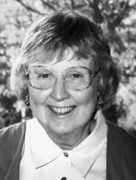By Shirley J. Nicholson
 One late afternoon in the flatlands of Illinois, with no hills or mountains to obstruct the view of the sky, my husband and I walked outside—to be caught up in a sense of awe. A rainbow stretched across the entire heavens, from horizon to horizon, a perfect arc of glowing colors against a clear blue ground. We stood spellbound and mute for several minutes.
One late afternoon in the flatlands of Illinois, with no hills or mountains to obstruct the view of the sky, my husband and I walked outside—to be caught up in a sense of awe. A rainbow stretched across the entire heavens, from horizon to horizon, a perfect arc of glowing colors against a clear blue ground. We stood spellbound and mute for several minutes.
Rainbows have always been arresting. Some are almost cosmic, like the one we saw. Some are miniature ones in a dewdrop on a leaf. Rainbows appear in the water from a lawn sprinkler, at the car wash, on soap bubbles. Little rainbows dance around the walls of a room from a crystal hanging in a window or from the facets of a diamond ring. Though rainbows are common, their perfect beauty awakens memories of another, more ethereal and more perfect, world.
Myths and legends from diverse cultures see rainbows as signs of the spiritual breaking into the mundane. According to legend, the Chumash Indians originated on Santa Cruz Island off the coast of southern California. Hutash, the Earth goddess, saw that the island was getting overpopulated. She decided that some of the Chumash must move to the mainland. But how would they get across the water? The goddess created a high rainbow that stretched from the tallest mountain on the island to the mountains near the coast of the mainland. Some of the people crossed the bridge and thrived on the other side. The rainbow brought them from the isolation of the island to solid land, from separation to unity. We call such a bridge "the Path."
Nature sometimes shows us analogies with hidden metaphysical structures and principles that guide the cosmos from within. The rainbow captures several such principles. Rainbow colors are a fleeting effect of water droplets separating the frequencies that make up clear light, as a prism breaks clear light into colors—seven as we count them. So rainbows remind us that we too are homogeneous, unified, all of the same basic light of atma, our deepest Self.
The rainbow's seven bands of color suggest the seven planes of nature and the seven principles in us that emerge from the clear light. Each band has a unique color, yet all are needed to form the whole rainbow, the complete unfolding of the clear light of atma. Both the world and we humans exist in many different frequencies, each distinct and unique but in no way separate or apart from the others.
Judy Garland sang about a land over the rainbow, where troubles melt like lemon drops. The ethereal beauty of the rainbow is reminiscent of such a place of pure joy and delight. The perfection of the archetypes, the "forms" as Plato called them, evoke a vision of a perfect world. Their mathematical precision guides the development of earthly forms. In a pine tree, for example, we can glimpse the mathematical perfection of "pine-tree-ness" behind the form that children approximate when they draw a Christmas tree. Though no tree in nature is perfect, that perfect form dwells within its imperfect reflections.
The rainbow we see is not substantial, not "real." There are no bright colors in the sky, nothing to grasp or hold. There is only our perception of seven colors refracted from clear light by passing through water droplets. The material world that seems so solid to our senses is also an illusion, maya as it is called in Eastern philosophy. We know from physical science that the "solid" stuff we bump against is really a dance of energy, of quanta. Esoteric philosophy holds that all the planes of nature, such as the astral or emotional and the mental—though more ethereal than the physical world—have no ultimate reality in themselves. They are temporary emanations from the One Clear Light behind the cosmos. As with so-called physical reality, their appearance depends on the perceptive powers of the observer.
Tibetan Buddhists claim that, after the death of a great yogi, rainbows keep appearing over the hut where the body lies undisturbed for a time. When they look inside several days after the death, they find only the hair and nails; the body has gone. Why not? From an ultimate point of view, the physical body is no more solid and real than the rainbow it becomes. For we are all but the stuff of rainbows. Yet we are also their source, the One Clear Light.
Shirley J. Nicholson until recently was director of the Krotona School of Theosophy in Ojai, California. For more than ten years she was senior editor for Quest Books, Wheaton, Illinois. She is author of Ancient Wisdom, Modern Insight and A Program for Living the Spiritual Life and has compiled several anthologies, including Karma: Rhythmic Return to Harmony. She has lectured and led workshops in this country and abroad

